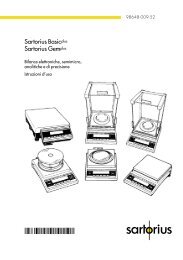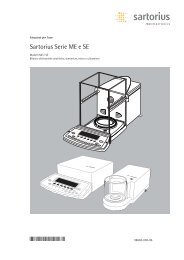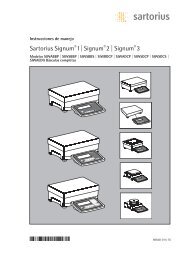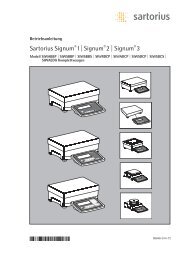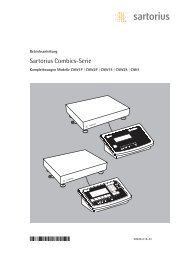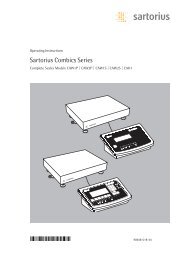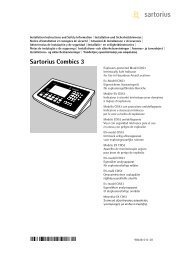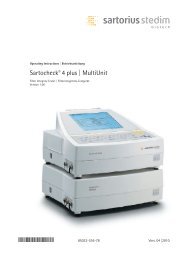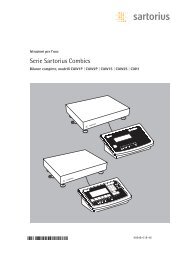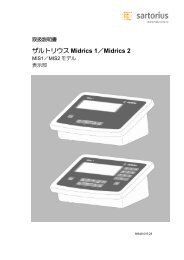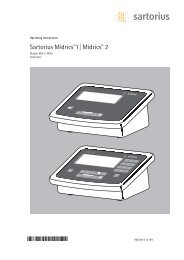MAN-Combics Complete Scale CAW3P CAW3S CAH3-e - Sartorius
MAN-Combics Complete Scale CAW3P CAW3S CAH3-e - Sartorius
MAN-Combics Complete Scale CAW3P CAW3S CAH3-e - Sartorius
You also want an ePaper? Increase the reach of your titles
YUMPU automatically turns print PDFs into web optimized ePapers that Google loves.
Configuring Weighing Platforms<br />
Select the desired configuration using the “Q“ or “q“ soft key. Confirm your<br />
selection using the “O“ key. Make additional settings in the submenu: scale interval<br />
d/verification scale interval e, minimum load (Verifiable configuration only),<br />
range limits (Multi-interval or Multiple range mode only) and maximum capacity.<br />
Confirm using the “l“ soft key or cancel using “Esc.“<br />
<strong>Scale</strong> Interval d <strong>Scale</strong> interval d indicates the resolution of the weighing instrument.<br />
The scale interval d can be entered only in increments of 1, 2, 5, 10, 20, etc.<br />
When using verifiable or verified weighing platforms, the scale interval d is the same<br />
as the verification scale interval e.<br />
Verification <strong>Scale</strong> Interval e The verification scale interval e indicates the resolution of the weighing instrument<br />
in legal metrology. The verification scale interval e can be entered only in<br />
increments of 1, 2, 5, 10, 20, etc. For weighing instruments of accuracy class l or<br />
m, e = d. This is why the scale interval d does not need to be entered separately.<br />
When “Standard configuration” is used, this menu item is not displayed.<br />
Minimum Capacity (Min. Cap.) When “Standard configuration” is used, this menu item is not displayed. The<br />
minimum load of the connected weighing platform is entered under this menu item.<br />
The minimum load for scales of accuracy class l is 20 e and 10 e for class m.<br />
Important Note: The function of the minimum load setting is to warn operators that below this<br />
limit, the summation of tolerances might lead to significant measurement errors. In<br />
Germany, for example, initial weights below the minimum load are not allowed.<br />
Maximum Capacity (Max. Cap.) The maximum capacity is the maximum load that may be placed on the weighing<br />
instrument. When heavier weights are used the weighing instrument displays<br />
overload “H.” The scale intervals of the weighing instrument are calculated using<br />
the maximum load and the scale interval d (e.g. max. capacity = 15.000 kg, smallest<br />
scale interval d = 0.005 kg yields 3000 scale intervals).<br />
In legal metrology the total number of intervals must be no more than 3000 e, and<br />
when using multi-interval scales there must not be more than 3000 e intervals per<br />
range.<br />
In standard operation, as opposed to legal metrology, you can define a “Super<br />
Range” weighing instrument of over 3000 intervals. These parameters, however,<br />
may be influenced by physical restrictions.<br />
Range 1, Range 2, Range 3 The range limits are entered for the individual ranges. The accuracy changes when<br />
these limits are exceeded. The following applies when entering limits: range 1<br />
< range 2 < range 3 < maximum capacity.<br />
This means that the weighing range can be divided into a maximum of 4 ranges.<br />
The resolution changes at intervals of 1, 2, 5, 10, 20 etc., where the lowest<br />
resolution is the smallest scale interval entered. Set ranges that are not required for<br />
use to zero.<br />
Available Units With this function, you can make particular weight units (weight unit x, x=1, 2)<br />
inaccessible during weighing. Available units are indicated by a * on the display<br />
(more than one can be selected).<br />
To enable or disable a unit, select the unit by pressing the “Q“ or “q“ soft key, and<br />
then press the “l“ soft key (toggle function).<br />
Saving Parameters To save the ADC configuration, use the “O“ soft key to select “Yes“ and confirm<br />
with the “l“ soft key. The device software is reset, and the scale returns to the<br />
normal weighing mode. To exit the menu without saving configuration changes,<br />
press the “o“ soft key.<br />
Once these parameters have been configured, the A/D converter in conjunction with<br />
the load cell(s) is defined as a weighing instrument. The A/D converter, in conjunction<br />
with the weighing platform, can now be used like any standard weighing<br />
platform. In addition, the weight unit must be defined and the weighing platform<br />
adjusted (calibration, adjustment and linearization must be performed). For a detailed<br />
description of these procedures, see the “Adjustment in Service Mode“ section.<br />
26 Operating Instructions <strong>Combics</strong> <strong>Complete</strong> <strong>Scale</strong>s



